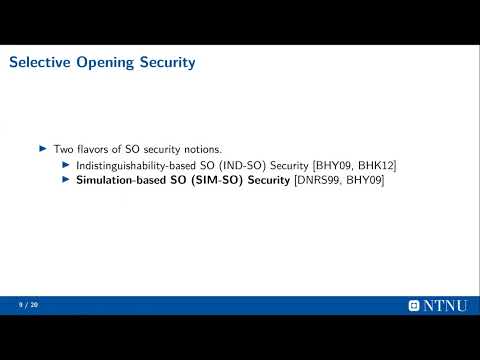CryptoDB
Compact and Tightly Selective-Opening Secure Public-key Encryption Schemes
| Authors: |
|
|---|---|
| Download: | |
| Presentation: | Slides |
| Conference: | ASIACRYPT 2022 |
| Abstract: | We propose four public-key encryption schemes with tight simulation-based selective-opening security against chosen-ciphertext attacks (SIM-SO-CCA) in the random oracle model. Our schemes only consist of small constant amounts of group elements in the ciphertext, ignoring smaller contributions from symmetric-key encryption, namely, they have compact ciphertexts. Furthermore, three of our schemes have compact public keys as well. Known (almost) tightly SIM-SO-CCA secure PKE schemes are due to the work of Lyu et al. (PKC 2018) and Libert et al. (Crypto 2017). They have either linear-size ciphertexts or linear-size public keys. Moreover, they only achieve almost tightness, namely, with security loss depending on the message bit-length. Different to them, our schemes are the first ones achieving both tight SIM-SO-CCA security and compactness. Our schemes can be divided into two families: - Direct Constructions. Our first three schemes are constructed directly based on the Strong Diffie-Hellman (StDH), Computational DH (CDH), and Decisional DH assumptions. Both their ciphertexts and public keys are compact. Their security loss is a small constant. Interestingly, our CDH-based construction is the first scheme achieving all these advantages based on a weak, search assumption. - A Generic Construction. Our last scheme is the well-known Fujisaki-Okamoto transformation. We show that it can turn a lossy encryption scheme into a tightly SIM-SO-CCA secure PKE. This transformation preserves both tightness and compactness of the underlying lossy encryption, which is in contrast to the non-tight proof of Heuer et al. (PKC 2015). |
Video from ASIACRYPT 2022
BibTeX
@inproceedings{asiacrypt-2022-32495,
title={Compact and Tightly Selective-Opening Secure Public-key Encryption Schemes},
publisher={Springer-Verlag},
author={Jiaxin Pan and Runzhi Zeng},
year=2022
}

